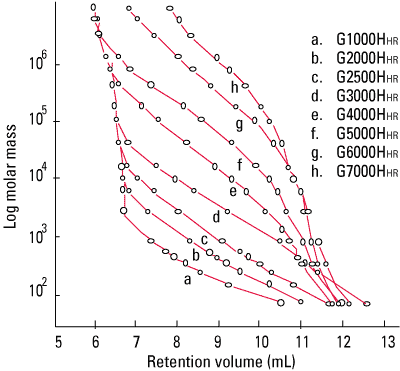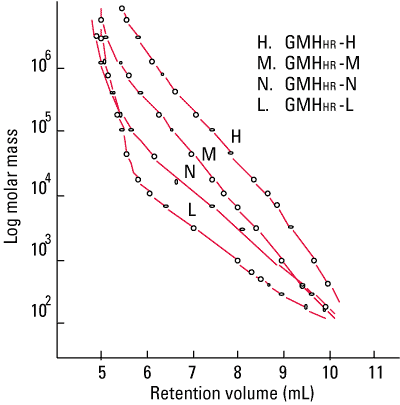TSKgel HHR Columns for Expanded Solvent Capability
The TSKgel HHR column line consists of eight columns with different pore sizes, TSKgel G1000HHR through TSKgel G7000HHR, and five columns with an extended linear range of the calibration curve. The calibration curves are shown below.
| Main characteristics |
| Maximum operating temperatures for TSKgel HHR columns is 140 °C for the conventional bed columns and 80 °C for the mixed bed columns. In addition, nine TSKgel HHR columns are available for high temperature and ultra-high temperature analysis, with maximum operating temperatures of 140 °C and 220 °C, respectively. |
| Broad solvent range. All TSKgel HHR columns are shipped in THF, which can be exchanged for a wide variety of organic solvents as shown below. |
| TSKgel HHR columns are conventional GPC columns with dimensions of 7.8 mm ID x 30 cm. Most HPLC systems do not require optimization of extra-column band broadening effects when working with conventional GPC columns. |
Columns with linear calibration curves
The TSKgel HHR product line contains five mixed bed columns, in which particles with different pore sizes are blended to provide an extended linear calibration curve. The mixd bed columns feature increasing linear calibration ranges, from TSKgel GMHHR-L, GMHHR-N, GMHHR-M, to GMHHR-H.
Calibration Curves on TSKgel HHR Columns
|
  |
Column: TSKgel HHR series, 7.8 mm ID x 30 cm
Sample: polystyrene standards
Elution: THF
Flow rate: 1.0 mL/min
Temperature: 25°C
Detection: UV@ 254 nm |
| Shipping Solvent |
Can Be Replaced With |
| Tetrahydrofuran 2,3 |
acetone, ethanol, quinoline, benzene, o-dichlorobenzene, ethyl acetate, dodecane, FC-113, carbon tetrachloride, dichloromethane, dichloroethane, trichloroethane, n-hexane, cyclohexane, xylene, tetrahydrofuran, chloroform, 1,4-dioxane, hexafluoroisopropanol, toluene, 1-chloronaphthalene, dimethylaceto acetamide, methyl ethyl ketone, trichlorobenzene, m-cresol, dimethylformamide, methylpyrrolidone, o-chlorophenol/chloroform, dimethyl sulfoxide, pyridine
|
Notes:
- See table below for appropriate flow rates for solvent exchange. After switching to a very polar solvent, switching to a nonpolar is not recommended.
- All TSKgel HHR analytical columns are shipped containing tetrahydrofuran (THF), except high temperature (HT) columns, which contain o-dichlorobenzene.
- Prolonged exposure to carbon tetrachloride can corrode the stainless steel parts of a column and an HPLC system.
* 100% methanol cannot be used with TSKgel H-type columns; use this solvent with TSKgel SW-type or Alpha columns.
| Solvent |
Recommended Flow Rate
|
n-Hexane
|
0.9
|
| methyl ethyl ketone |
0.7 |
| dichloromethane, ethyl acetate |
0.6 |
| toluene, chloroform |
0.5 |
| dimethylformamide |
0.4 |
| carbon tetrachloride, pyridine |
0.3 |
| dimethyl sulfoxide, dioxane, ethanol, N-methylpyrrolidone, o-dichlorobenzene |
0.2 |
| quinoline, hexafluoroisopropanal, 1-chloronaphthalene |
0.1 |
| Recommended Solvent |
Application
|
THF
|
polystyrene, epoxy resin, phenoxy resin, polycarbonate, polyisoprene, polyvinyl acetate, polyvinyl chloride, monoglycerides, fatty acids, poly(butadiene), polybutadiene, poly(methyl methacrylate), poly(styrene-butadiene), poly(styrene-acrylonitrile)
|
| N,N-Dimethylformamide (DMF) +/- 5mM LiBr |
polyvinyl chloride, polyvinyl fluoride, urea resins, polyurethane, polystyrene, polyester,
polyimido ether, polyimido ester, polyphenol (aqueous solution), polyacrylonitrile |
o-Dichlorobenzene (ODCB)
|
polyethylene, polypropylene
|
Chloroform
|
polycarboxylic ether, acrylic resin, epoxy resin, polystyrene
|
m-Cresol/Chloroform
|
nylon, polyester, polyamide, poly(ethylene terephthalate)
|
Toluene
|
polybutadiene, polysiloxane
|